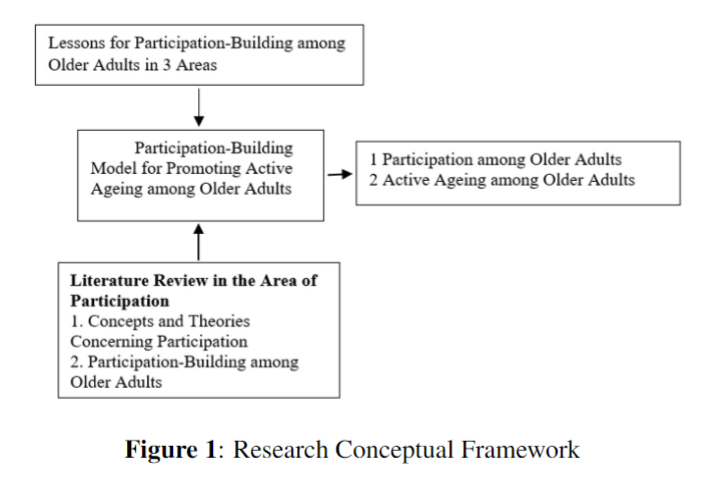Developing A Participation-Building Model for Promoting Active Ageing among Older Adults
Main Article Content
Abstract
This study aimed to develop and study the effects of a participation-building model for promoting active ageing among older adults. The methodology in this study was a mixed method, including 1) deriving lessons from three best practice areas with high indices of older adult participation, 2) use of data from Stage 1 as baseline information presented in focus group discussions for developing the model, and 3) study of the effects of the Participation-Building Model for Promoting Active Ageing among Older Adults through quasi-experimental research. The results show a model consisting of area executives with the following policies and plans for supporting older adults who have the leisure to participate in social activities: 1) modifying facilities, environments, and communications; 2) supplying necessary equipment; and 3) providing lecturers to offer knowledge about activities, self-care, and communication technology. The people responsible for providing information and coordinating activities were arranged. At six months after the quasi-experiment, the mean scores of the experimental group were higher than the control group (t = 7.166, p =.000 and t = 7.570, p =.000, respectively). In addition, the experimental group’s mean scores for posttest participation and active ageing were found to be higher than the pretest scores (t = -4.030, p =.000 and t = -3.422, p =.002, respectively).
According to the findings, the older adults who participated in social activities were found to have higher levels of engagement in active ageing with greater ability for self-care and security while participating in activities continually with a generally friendly attitude toward their surroundings. Therefore, it can be concluded that the program provides guidelines for promoting participation among older adults so they can be ready to perform activities in daily life, have good health, and be independent.
Article Details

This work is licensed under a Creative Commons Attribution-NonCommercial-NoDerivatives 4.0 International License.
References
W. Chewasopit, Ageing Society: The Changed Marketing Factor. Journal of MCU Nakhondhat, 6(1) (2019) 38–54.
B. Siripanich, Situation of the Thai Elderly. Foundation of Thai Gerontology research and
Development. 2018. https://thaitgri.org/pSirasa (accessed 3 Apr 2020).
National Health Security Office.(2016). Manual of Service Management Support long term care system in public health for dependent elderly in health security system, Bangkok: National Health Security Office Press, 2016.
H.Thomason. The meaning and potential of active ageing: A mixed-methods analysis in a sample of Australian and Portuguese older adults. (Doctor of Philosophy thesis). The University of Queensland School of Psychology, 2015.
C. Eliopoulos, Gerontological nursing (9th ed.), Philadelphia: Wolters Kluwer, 2018.
S. Chansarn, Active ageing of Thai elderly people, The demographic dividends and Thailand’s economic prospect in an ageing society, Journal of Srinakharinwirot Research and Development (Journal of Humanities and Social Sciences), 4(7) (2012) 201–214.
National Statistical Office, Ministry of Digital Economy and Society, Active ageing index of Thai elderly, Bangkok: Text and Journal Publication Company Limited, 2017.
H. Douglas, A. Georgiou & J. Westbrook, Social participation as an indicator of successful aging: an overview of concepts and their associations with health. Australian health review, 41(4) (2017) 455–462.
F. Sun, I. J. Norman, I. J. & A. E. While, Physical activity in older people: a systematic review, BMC public health, 13 (2013) 449. https://doi.org/10.1186/1471-2458-13-449
L. Duxbury & M. Halinski, When more is less: An examination of the relationship between hours in telework and role overload. Work (Reading, Mass.) 48(1) (2014) 91–103. https://doi.org/10.3233/WOR-141858
J. M. Pinto & A. L. Neri. Factors related to low social participation in older adults: findings from the Fibra study, Brazil. Cad. saúde colet 25(3) (2017) 286-293. https://doi.org/10.1590/1414-462X201700030300
G. Bonaccorsi, et al., Impact of the Built Environment and the Neighborhood in Promoting the Physical Activity and the Healthy Aging in Older People: An Umbrella Review, International Journal of Environmental Research and Public Health, 17(17) (2020) 6127. https://doi.org/10.3390/ijerph17176127
D. Duppen, et al, Social Participation in the Daily Lives of Frail Older Adults: Types of Participation and Influencing Factors. The journals of gerontology. Series B, Psychological sciences and social sciences, 75(9) (2020) 2062–2071. https://doi.org/10.1093/geronb/gbz045
M. Galanakis, S. Tsoli & C. Darviri, The Effects of Patient Empowerment Scale in
Chronic Diseases, Psychology, 7 (2016) 1369-1390.
I. Singnoi & R. Thasanai, Public Policy: Government Administration and Management, Journal of MCU Peace Studies Special Issue, (2018) 610-623. https://so03.tci-thaijo.org/index.php/journal-peace/article/view/116467.
J. Ryu & J. Heo, Relationships between leisure activity types and well-being in
older adults, Leisure Studies, 37 (2018) 331 - 342.
M. Dehi Aroogh & F. Mohammadi Shahboulagh, Social participation of older adults: A concept analysis, International journal of community based nursing and midwifery, 8(1) (2020) 55–72.
J. Wongprom, K. Jongwutiwes, N. Prasertsuk, & N. Jongwutiwes, (2015). Community Participation in the development of Older Persons’ Quality of Life, Journal,Slipakorn University, 8(3) (2015) 41-54.
J. Siette, et al, Social Participation Among Older Adults Receiving Community Care Services, Journal of Applied Gerontology, 40(9) (2021) 997–1007. https://doi.org/10.1177/0733464820938973
M. Zingmark, R. Ankre & S. Wall-Reinius, Promoting outdoor recreation among older adults in Sweden – a theoretical and empirical foundation for the development of an intervention, Arch Public Health 79: 232 (2021). https://doi.org/10.1186/s13690-021-00762-6
J. M. Perkins, K. S. Multhaup, H. W. Perkins & C. Barton, Self-efficacy and participation in physical and social activity among older adults in Spain and the United States, The Gerontologist, 48(1) (2008) 51–58. https://doi.org/10.1093/geront/48.1.51
A. Zaidi & K. Howse, The Policy Discourse of Active Ageing: Some Reflections. Population Ageing 10 (2017) 1–10. https://doi.org/10.1007/s12062-017-9174-6
M. Levasseur, et al, Social participation needs of older adults living in a rural regional county municipality: toward reducing situations of isolation and vulnerability, BMC Geriatrics 20: 456 (2020). https://doi.org/10.1186/s12877-020-01849-5
M. S. Reed, et al, A theory of participation: what makes stakeholder and public
engagement in environmental management work?, Restor Ecol, 26 (2018) S7-S17. https://doi.org/10.1111/rec.12541
A. Punyakaew, H-Y. Hsu, S. Lersilp & S. Putthinoi, Active Ageing Levels and Time Use Patterns in Social Participation of Active Ageing. Nursing Journal of the Ministry of Public Health, 31(1) (2021) 177-188. https://he02.tci-thaijo.org/index.php/tnaph/article/view/250680


